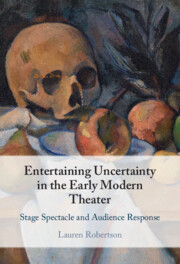Book contents
Chapter 1 - Bodies
from Part I - Dramatic Action
Published online by Cambridge University Press: 02 February 2023
Summary
By attending to a common theatrical convention – the representation of both dead and apparently dead bodies by actors – Chapter 1 offers a new history of early modern English tragicomedy. In all theatrical performance, the actor’s body is semiotically volatile, for its liveliness can never be entirely circumscribed by the onstage fiction. This chapter demonstrates that the early modern theater frequently exacerbated that necessary instability by requiring its actors to feign death. Tracking instances of apparent death from the late 1580s through the opening of the seventeenth century, the chapter shows that theater practitioners increasingly invited their spectators to apprehend the ambiguity of the lively stage corpse, entwining them in uncertainty by offering them less and less interpretive guidance about the actor’s inevitable signs of life. Audiences gradually came to expect that they could not know the fictional status of apparent corpses. The conventions that eventually coalesced around stage corpses enabled the rise of English tragicomedy, the hybrid genre that allowed for seemingly dead bodies to resurrect themselves without warning.
Keywords
- Type
- Chapter
- Information
- Entertaining Uncertainty in the Early Modern TheaterStage Spectacle and Audience Response, pp. 35 - 70Publisher: Cambridge University PressPrint publication year: 2023

